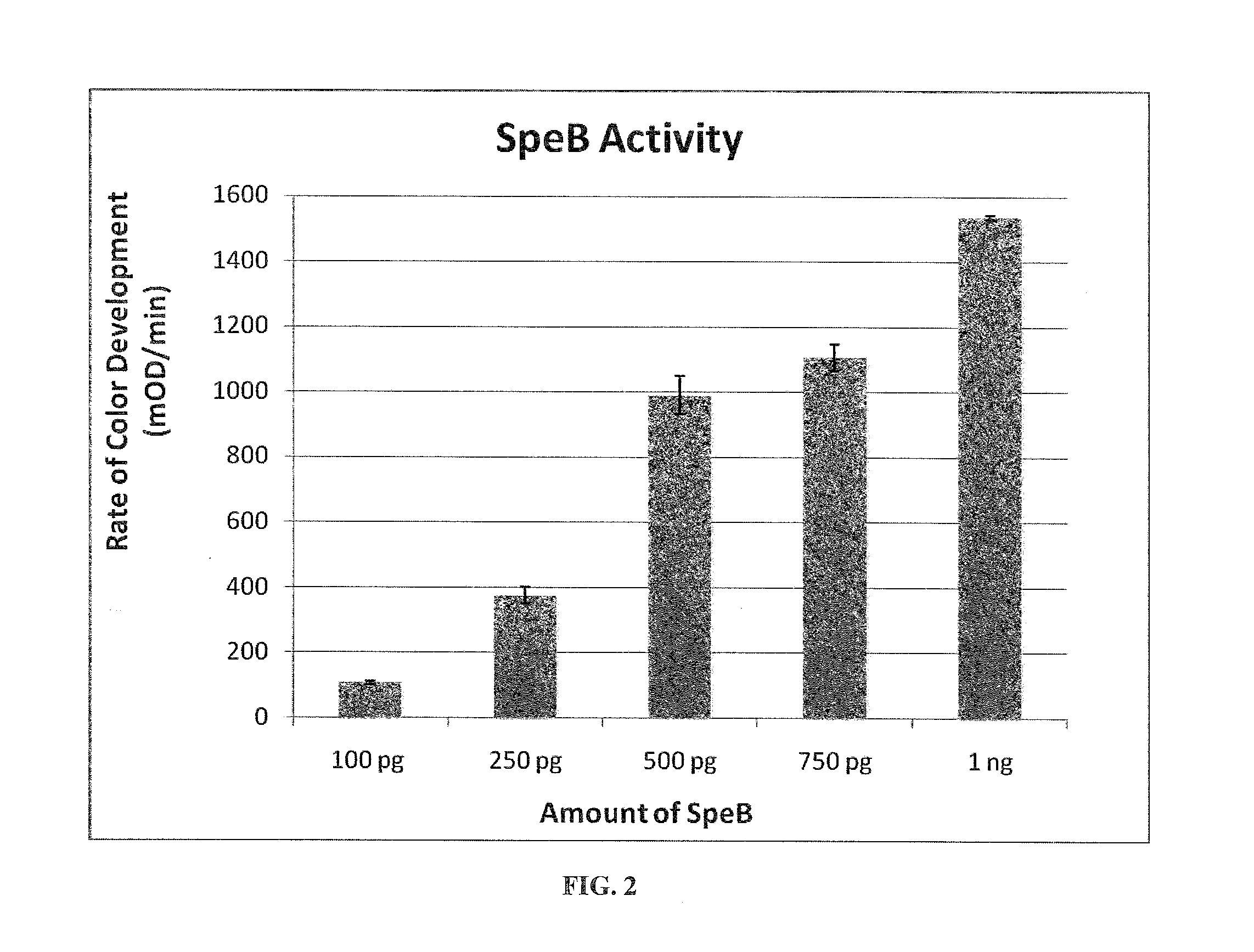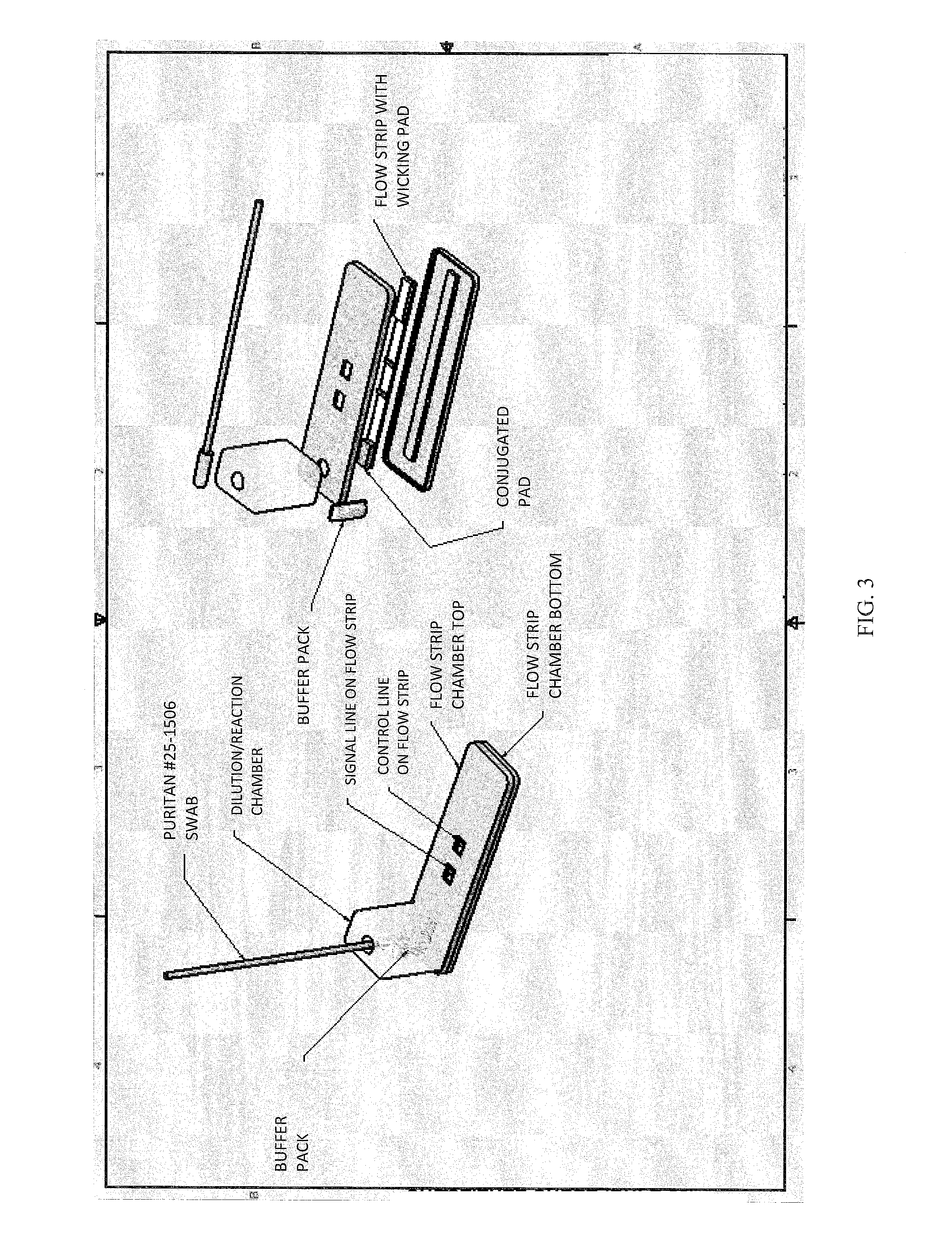Ultrasensitive detection of beta hemolytic streptococcus
a technology of beta hemolytic streptococcus and ultrasensitive detection, which is applied in the direction of instruments, peptides/protein ingredients, peptides, etc., can solve the problems of poor sensitivity of antibody-based tests, inapplicability to consumer use, and considerable time lost from work, etc., and achieves high sensitivity
- Summary
- Abstract
- Description
- Claims
- Application Information
AI Technical Summary
Benefits of technology
Problems solved by technology
Method used
Image
Examples
example 1
Detection of Streptococcus pyogenes
[0105]The hydrolysis of a Streptococcus pyogenes-specific peptide FLVMFLSG (SEQ. ID. NO.: 1) from Tris Acryl or Hyper D beads was used to detect Streptococcus pyogenes in samples. The signal of this peptide hydrolysis reaction was reamplified by binding of the released substrate to a gold conjugate (or NTA-HRP) and measured by lateral flow technology or microplate assay. Use of the peptide of SEQ. ID. NO.: 1 in a microplate assay (EXPRESS DETECT®, ECI, Worcester, Mass.) resulted in detection of S. pyogenes at levels lower than those detected by the broad spectrum peptide, CPI2 (see WO2005 / 0427700, the contents of which are incorporated herein in their entirety).
[0106]FIG. 1 is a plot of S. pyogenes concentration (CFU / mL) versus the rate of color development (mOD / min) and illustrates the detection of S. pyogenes in a sample by measuring the color development that results when the S. pyogenes-specific peptide, H11 (SEQ. ID. NO.: 1), is hydrolyzed fr...
example 2
Example of a Lateral Flow Device
[0107]A detectable label comprising a dual affinity tag (biotin and polyhistidine) is covalently linked to the C-terminus of a peptide substrate, which in turn IS linked to the surface of a bead. The detectable label, the peptide substrate, and the bead, together, make up the first conjugate. Microbial proteases present in Streptococcus cleave a multiplicity of first conjugate peptide substrates, releasing free detectable label from the bead. After release by proteases, the free detectable label (also referred to herein as modified first conjugate) is separated from the beads and unmodified first conjugate by filtration through a lateral flow membrane device.
[0108]A solution containing the released detectable label is applied directly to a lateral flow strip or a conjugate pad in fluid communication with the lateral flow strip. The lateral flow strip has a first region containing an excess of second conjugate, for instance, nanometer-sized gold nanopa...
example 3
Microplate Assay for Analysis of Streptococcus Samples
[0113]FIG. 2 is a plot of the amount of streptococcal pyogenix exotoxin B (SpeB) (ng or pg) versus the rate of color development (mOD / min) and illustrates the detection of SpeB in a sample by measuring the color development that results when H11 peptide is hydrolyzed from beads and amplified using NTA-HRP. SpeB was purified from S. pyogenes growth media according to Kapur et al. PNAS: 1993, vol. 90, no. 16, pages 7676-7680 (with minor modifications). Cell-free growth media from S. pyogenes was desalted on a G25 Sephadex column, then SpeB was purified by affinity chromatography using a Reactive Red-120 agarose column. Purified SpeB was diluted to 1-10 ng / mL in 50 mM Tris buffer, pH 8.0, and a 100-μl aliquot was tested for proteolytic activity in a microplate assay (ECI, Worcester, Mass.) with the peptide of SEQ. ID. NO.: 1. The lower limit of detection was 100 pg of purified SpeB. A detailed procedure is outlined below:
[0114]Clini...
PUM
| Property | Measurement | Unit |
|---|---|---|
| Diameter | aaaaa | aaaaa |
| Diameter | aaaaa | aaaaa |
| Size | aaaaa | aaaaa |
Abstract
Description
Claims
Application Information
 Login to View More
Login to View More - R&D
- Intellectual Property
- Life Sciences
- Materials
- Tech Scout
- Unparalleled Data Quality
- Higher Quality Content
- 60% Fewer Hallucinations
Browse by: Latest US Patents, China's latest patents, Technical Efficacy Thesaurus, Application Domain, Technology Topic, Popular Technical Reports.
© 2025 PatSnap. All rights reserved.Legal|Privacy policy|Modern Slavery Act Transparency Statement|Sitemap|About US| Contact US: help@patsnap.com



